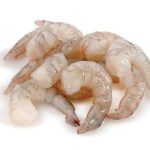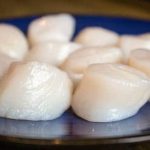Buying seafood can be very hard if you don't know what to look for. So here are a few tips that will help you make the best choice.
- Use your eyes, hands,and nose when selecting fresh fish or shellfish. Fresh whole fish should have bright, clear eyes that are often protruding, bright red or pink gills, firm yet elastic flesh, and shiny skin. Your purchase should feel cold, not cool, to the touch.And it shouldn’t smell “fishy.”The odor should be that of a fresh sea breeze.
- Fish Fillets or Steaks.
 Note that fillets and steaks should have firm, elastic flesh and a fresh-cut, moist appearance, with no browning around the edges. Fillets separate if they are left too long in the case. The flesh should be almost translucent — as if you can almost see through it. There should be little evidence of bruising or reddening of the flesh from retention of blood. Prepackaged steaks and fillets should contain a minimum of liquid. Fish fillets stored in liquid deteriorate quickly.
Note that fillets and steaks should have firm, elastic flesh and a fresh-cut, moist appearance, with no browning around the edges. Fillets separate if they are left too long in the case. The flesh should be almost translucent — as if you can almost see through it. There should be little evidence of bruising or reddening of the flesh from retention of blood. Prepackaged steaks and fillets should contain a minimum of liquid. Fish fillets stored in liquid deteriorate quickly. - Shellfish.
 They may be sold live, cooked, or fresh-shucked. Each form and species has different quality signs to examine.The shells of live clams, oysters, or mussels should look moist and be tightly closed. If the shells gape slightly, have your retailer tap them. If the shells do not close, do not purchase them. Do not purchase live shellfish with cracked shells. The bottom shell of an oyster should be well cupped — a sign that the oyster inside is plump and well formed. The “neck” or “snout” of soft-shelled clams should show movement.The meats of fresh-shucked clams, oysters, or mussels should be plump and covered with their liquor. Their liquor should be clear or slightly opalescent (slightly milky or light gray) and free of shell or grit. There should be no strong odor.
They may be sold live, cooked, or fresh-shucked. Each form and species has different quality signs to examine.The shells of live clams, oysters, or mussels should look moist and be tightly closed. If the shells gape slightly, have your retailer tap them. If the shells do not close, do not purchase them. Do not purchase live shellfish with cracked shells. The bottom shell of an oyster should be well cupped — a sign that the oyster inside is plump and well formed. The “neck” or “snout” of soft-shelled clams should show movement.The meats of fresh-shucked clams, oysters, or mussels should be plump and covered with their liquor. Their liquor should be clear or slightly opalescent (slightly milky or light gray) and free of shell or grit. There should be no strong odor.
- Raw shrimp
 meat should be firm and have a mild odor. The shells of most varieties are translucent with a grayish green, pinkish tan, or light pink tint.The shells should not have blackened edges or black spots — this is a sign of quality loss. Cooked shrimp meat should be firm and have no disagreeable odor. The color of the meat should be white with red or pink tints. Tiger shrimp have blueish colored shells with black lines between the segments of the shell (these are not black spots).
meat should be firm and have a mild odor. The shells of most varieties are translucent with a grayish green, pinkish tan, or light pink tint.The shells should not have blackened edges or black spots — this is a sign of quality loss. Cooked shrimp meat should be firm and have no disagreeable odor. The color of the meat should be white with red or pink tints. Tiger shrimp have blueish colored shells with black lines between the segments of the shell (these are not black spots). - Scallops
 are not usually sold live because they are highly perishable. Typically scallops are shucked at sea shortly after capture. On occasion, day boats will bring whole scallops to market or local restaurants. Fresh scallop meats have a firm texture and a distinctly sweet odor. A sour or iodine smell indicates spoilage. The smaller bay and calico scallops are usually creamy white, although there may be some normal light tan or pink coloration. The larger sea scallops are also generally creamy white, although they may show some normal light orange or pink color.
are not usually sold live because they are highly perishable. Typically scallops are shucked at sea shortly after capture. On occasion, day boats will bring whole scallops to market or local restaurants. Fresh scallop meats have a firm texture and a distinctly sweet odor. A sour or iodine smell indicates spoilage. The smaller bay and calico scallops are usually creamy white, although there may be some normal light tan or pink coloration. The larger sea scallops are also generally creamy white, although they may show some normal light orange or pink color.
Hope this helps when selecting seafood! As always, please feel free to reach out to me with any questions.
Resource info from JSE Certified Personal Fitness Chef Seafood Safe-Handling



